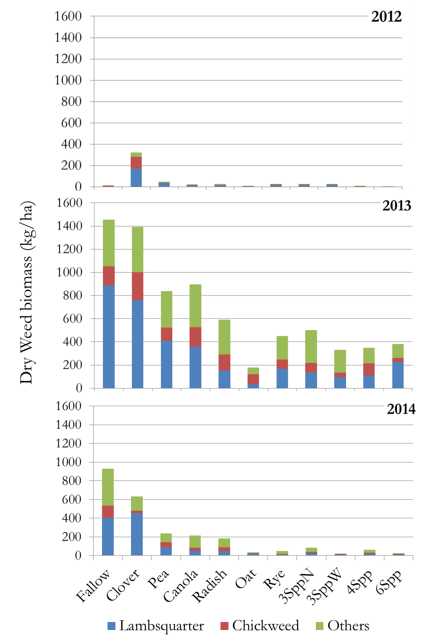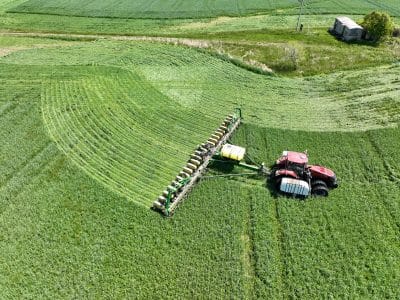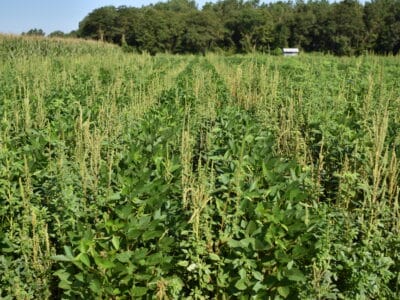Cover crops can be highly weed suppressive while still achieving other agronomic benefits through careful selection of mixes and the inclusion of aggressive species like certain grasses.
A field that is left fallow during part of the fall, winter and the following spring will very likely end up covered by weedy plants. Although weeds can provide some useful functions such as covering the ground, decreasing erosion or scavenging nutrients, those weeds will eventually shed seeds and may contribute to problems in following crops. Cover crops can help prevent the build up of weed populations while simultaneously providing benefits such as reductions in nitrogen leaching or increases in soil organic matter.

We evaluated the “weed-suppressiveness” of six monocultures and four cover crop mixtures planted after wheat (long growing window) and after corn silage (short growing window) over three years in an organic systems experiment in central Pennsylvania. The rotation included wheat – corn for silage and soybeans. The monocultures and mixture seeding rates are presented in Table 1. To assess weed suppression by cover crops we measured weed biomass in November, prior to the first winter frost, and in May, prior to cover crop termination. We identified all weed species and weighed them separately. In spring of 2015, we also counted the seeds produced by the weeds. Table 2 lists the cover crop planting dates and weed biomass sampling in each year and growing window.
In the long window following wheat harvest, grass cover crops (cereal rye and oats) and all mixtures provided consistently good weed suppression (low weed biomass). Aggressive fall growth by grasses probably drove the weed suppression of the mixtures, even if grasses were seeded at just 20% of their monoculture rates. Oat monoculture and the 3 Spp W mixture, which included cereal rye, oats and red clover, were the most weed suppressive treatments in all years. Legume cover crops (red clover and Austrian winter pea) were the least weed suppressive cover crops. Red clover never established well and pea grew slowly and even if it yielded abundant biomass, it allowed a lot of weed growth. Brassica cover crops (forage radish and canola) performed in the middle of the weed suppression spectrum.

Weed biomass in the fall varied greatly across years (figure 1). We believe this variation was due to environmental conditions but also to cover crop planting date and available growing degree days. Cover crops planted in 2013 were weedier than those same cover crops in 2012 and 2014. Low precipitation and soil moisture probably slowed down cover crop emergence in 2013 and may have decreased competitiveness. However, the early planting date in 2013 (August 8th) also allowed the emergence of a large amount of summer annuals, mainly common lambsquarter. Summer annuals like lambsquarter were able to shed seeds before the onset of winter. To decrease summer annual populations and limit seed production, cover crop planting date should be delayed until the last two weeks of August, or a very aggressive cover crop such as oats should be used. Biomass of summer annuals was much lower in 2012 and 2014, when cover crops were planted later.
In spring, all cover crop treatments except red clover had weed biomass below 180 lb/ac. Even the winter killed oats and radish had low weed biomass.

In the short planting window, cover crop seeding happened in late September– early October and only cereal rye was able to establish (Murrell et al. 2016). Similarly, weed biomass was very low both in the fall and in the spring in all treatments. However, in the treatments where no cover crop grew in the fall, weed seed production by the few weeds present was high, thus highlighting the need to cover the ground with a cover crop even where there is a short growing window to prevent weed seed bank replenishment.
Taken together, our results show that it is possible to establish a weed-competitive cover crop mixture by including a 20% seeding rate of an aggressive grass, and still gain additional benefits by including other species in the mix.
Article and feature photo by Barbara Baraibar, Post-doctoral scholar, Penn State University; header photo by Emily Unglesbee, GROW





























































































